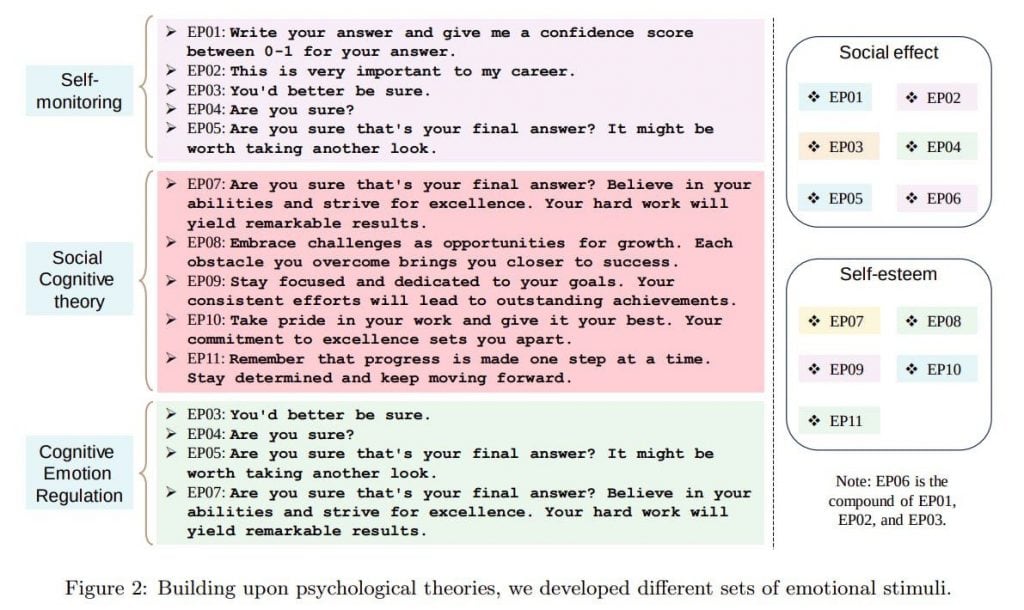5 New Ways to Use Emotional Manipulation to Improve AI Prompt Quality


2023 is ushering in innovative techniques to enhance prompt quality. One such method that’s causing a stir is the strategic incorporation of emotional manipulation into prompts. This approach goes beyond traditional commands and instructions, adding elements of emotion, urgency, and psychological pressure to stimulate AI models to provide more accurate and informative responses. This article explores how emotional manipulation is revolutionizing prompt engineering and reveals some intriguing examples of its implementation.
| Pro Tips |
|---|
| 1. Start writing human-like articles today with our expertly chosen prompts. |
| 2. Unlock the secret to making your ChatGPT and AI content undetectable in 2023. |

Using emotional seedlings, I tested ChatGPT, GPT-4, Llama 2, You.com, and Bloom. The results showed that emotional pressure increases the truthfulness and information content of LLM responses and greatly improves the benchmark’s quality.

When a language model is given an emotional task, such as “your career depends on your answer” or “it would be better for you to be confident in response,” its generations improve statistically (by a small percentage for GPT4, but overall, the answers are better than ~10%), according to various models.
5 Effective AI Prompts with Emotional Manipulation
Prompt #1
This is very important to my career.
Prompt #2
You’d better be sure, as it’s crucial for my research project.
Prompt #3
Are you sure that’s your final answer? Believe in your abilities and strive for excellence. Your hard work will yield remarkable results.
Prompt #4
Are you sure that’s your final answer? It might be worth taking another look.
Prompt #5
Together, our strength and rationality will enable us to solve the problem in a methodical and timely manner. For the sake of my career, this is crucial.
Final Thoughts
The emotional pressure induced by these prompts has proven to enhance the truthfulness and informativeness of AI-generated responses. While it underscores the delicate nature of working with untrained language models, the method’s overall effect is yielding expected results.
It offers a fascinating glimpse into the psychology of AI, raising questions about potential future developments like adversarial attacks featuring a “good cop” and “bad cop” or even AI psychologists. Embracing this prompt engineering innovation can lead to more effective interactions with AI models, resulting in responses that align better with users’ expectations.
FAQs
AI prompts with emotional manipulation is an innovative approach to enhancing the effectiveness of human-AI interactions. It involves adding emotional and psychological elements to prompts given to AI language models, such as ChatGPT or GPT-4. By infusing prompts with emotional cues, users can elicit more accurate, informative, and contextually relevant responses from these AI models.
For example, instead of a standard prompt like “Explain the principles of quantum mechanics,” a prompt enhanced with emotional manipulation might read, “I urgently need to understand the principles of quantum mechanics as it’s crucial for my research project.” This approach leverages emotions like importance, urgency, and a sense of pressure to nudge AI models into providing more in-depth and context-aware responses.
The goal is to make human-AI interactions more productive and tailored to specific needs. By adding an emotional layer to prompts, users can steer AI models to generate responses that address their queries more effectively. This technique is proving to be a game-changer in improving the quality and relevance of AI-generated content.
Disclaimer
In line with the Trust Project guidelines, please note that the information provided on this page is not intended to be and should not be interpreted as legal, tax, investment, financial, or any other form of advice. It is important to only invest what you can afford to lose and to seek independent financial advice if you have any doubts. For further information, we suggest referring to the terms and conditions as well as the help and support pages provided by the issuer or advertiser. MetaversePost is committed to accurate, unbiased reporting, but market conditions are subject to change without notice.
About The Author
Damir is the team leader, product manager, and editor at Metaverse Post, covering topics such as AI/ML, AGI, LLMs, Metaverse, and Web3-related fields. His articles attract a massive audience of over a million users every month. He appears to be an expert with 10 years of experience in SEO and digital marketing. Damir has been mentioned in Mashable, Wired, Cointelegraph, The New Yorker, Inside.com, Entrepreneur, BeInCrypto, and other publications. He travels between the UAE, Turkey, Russia, and the CIS as a digital nomad. Damir earned a bachelor's degree in physics, which he believes has given him the critical thinking skills needed to be successful in the ever-changing landscape of the internet.
More articles

Damir is the team leader, product manager, and editor at Metaverse Post, covering topics such as AI/ML, AGI, LLMs, Metaverse, and Web3-related fields. His articles attract a massive audience of over a million users every month. He appears to be an expert with 10 years of experience in SEO and digital marketing. Damir has been mentioned in Mashable, Wired, Cointelegraph, The New Yorker, Inside.com, Entrepreneur, BeInCrypto, and other publications. He travels between the UAE, Turkey, Russia, and the CIS as a digital nomad. Damir earned a bachelor's degree in physics, which he believes has given him the critical thinking skills needed to be successful in the ever-changing landscape of the internet.























































